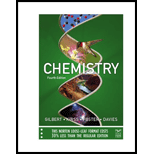
Concept explainers
(a)
Interpretation: The molecules in which phosphorus atom has an expanded valence shell is to be stated.
Concept introduction:
To determine: If phosphorus atom has an expanded valence shell in
(a)
Answer to Problem 8.98QP
Phosphorus has an expanded valence shell in
Explanation of Solution
Explanation
The atomic number of phosphorus is
The ground state electronic configuration of
The excited state electronic configuration of
The atomic number of oxygen is
The ground state electronic configuration of
The atomic number of chlorine is
The ground state electronic configuration of
There are five unpaired electrons in excited state of phosphorus due to promotion of electron to available d orbital. The unpaired electrons in oxygen is
(b)
To determine: If phosphorus atom has an expanded valence shell in
(b)
Answer to Problem 8.98QP
Phosphorus has an expanded valence shell in
Explanation of Solution
Explanation
The atomic number of phosphorus is
The ground state electronic configuration of
The excited state electronic configuration of
The atomic number of flourine is
The ground state electronic configuration of
There are five unpaired electrons in excited state of phosphorus due to promotion of electron to available d orbital. There are
(c)
To determine: If phosphorus atom has an expanded valence shell in
(c)
Answer to Problem 8.98QP
Phosphorus does not have an expanded valence shell in
Explanation of Solution
Explanation
The atomic number of phosphorus is
The ground state electronic configuration of
The atomic number of flourine is
The ground state electronic configuration of
There are three unpaired electrons in ground state of phosphorus. There are
(d)
To determine: If phosphorus atom has an expanded valence shell in
(d)
Answer to Problem 8.98QP
Phosphorus does not have an expanded valence shell in
Explanation of Solution
Explanation
The atomic number of phosphorus is
The ground state electronic configuration of
The atomic number of flourine is
The ground state electronic configuration of
There are three unpaired electrons in ground state of phosphorus.
Fluorine has one unpaired electron in its valence orbital. The two fluorine atoms will react with two unpaired electrons that are located at the
Want to see more full solutions like this?
Chapter 8 Solutions
Chemistry: The Science in Context (Fourth Edition)
- What are the missing intermediates 1, 2, and 3? Please include a detailed explanation explaining the steps of malonic ester synthesis. Please include drawings of the intermediates and how they occur.arrow_forwardWhat is the reactant that makes the following product of the reaction? Please provide a detailed explanation and a drawing to show how the reaction proceeds.arrow_forwardDraw the products formed when each ester is hydrolyzed with water and sulfuric acid.arrow_forward
- Draw the complete structural formula from each condensed structure. include all hydrogen atoms.arrow_forwardDraw the complete structural formula from each condensed structure. Include all hydrogen atoms.arrow_forwardIndicate how H2O2 intervenes in the synthesis of K4[Co2(C2O4)4(OH)2]. Write the reactions.arrow_forward
- Explain how, based on physical gas adsorption isotherms, we can determine whether multi-walled C nanotubes are open at their ends. Explain this.arrow_forwardcan somone answer pleasearrow_forwardConstruct a molecular orbital energy-level diagram for BeH2. Sketch the MO pictures (schematic representation) for the HOMO and LUMO of BeH2 [Orbital Potential Energies, H (1s): -13.6 eV; Be (2s): -9.3 eV, Be (2p): -6.0 eV]arrow_forward
- Indicate the isomers of the A(H2O)6Cl3 complex. State the type of isomerism they exhibit and explain it briefly.arrow_forwardState the formula of the compound potassium μ-dihydroxydicobaltate (III) tetraoxalate.arrow_forwardConsider the reaction of the cyclopentanone derivative shown below. i) NaOCH2CH3 CH3CH2OH, 25°C ii) CH3!arrow_forward
 ChemistryChemistryISBN:9781305957404Author:Steven S. Zumdahl, Susan A. Zumdahl, Donald J. DeCostePublisher:Cengage Learning
ChemistryChemistryISBN:9781305957404Author:Steven S. Zumdahl, Susan A. Zumdahl, Donald J. DeCostePublisher:Cengage Learning ChemistryChemistryISBN:9781259911156Author:Raymond Chang Dr., Jason Overby ProfessorPublisher:McGraw-Hill Education
ChemistryChemistryISBN:9781259911156Author:Raymond Chang Dr., Jason Overby ProfessorPublisher:McGraw-Hill Education Principles of Instrumental AnalysisChemistryISBN:9781305577213Author:Douglas A. Skoog, F. James Holler, Stanley R. CrouchPublisher:Cengage Learning
Principles of Instrumental AnalysisChemistryISBN:9781305577213Author:Douglas A. Skoog, F. James Holler, Stanley R. CrouchPublisher:Cengage Learning Organic ChemistryChemistryISBN:9780078021558Author:Janice Gorzynski Smith Dr.Publisher:McGraw-Hill Education
Organic ChemistryChemistryISBN:9780078021558Author:Janice Gorzynski Smith Dr.Publisher:McGraw-Hill Education Chemistry: Principles and ReactionsChemistryISBN:9781305079373Author:William L. Masterton, Cecile N. HurleyPublisher:Cengage Learning
Chemistry: Principles and ReactionsChemistryISBN:9781305079373Author:William L. Masterton, Cecile N. HurleyPublisher:Cengage Learning Elementary Principles of Chemical Processes, Bind...ChemistryISBN:9781118431221Author:Richard M. Felder, Ronald W. Rousseau, Lisa G. BullardPublisher:WILEY
Elementary Principles of Chemical Processes, Bind...ChemistryISBN:9781118431221Author:Richard M. Felder, Ronald W. Rousseau, Lisa G. BullardPublisher:WILEY





